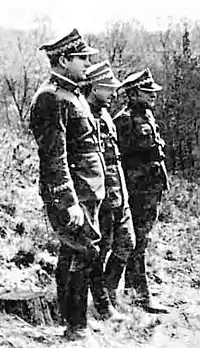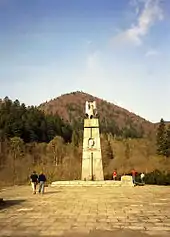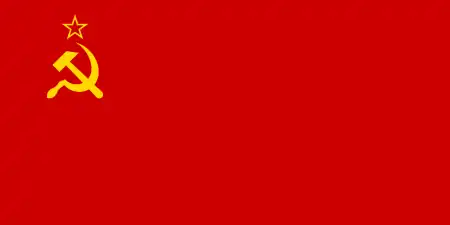Karol Świerczewski
Karol Wacław Świerczewski (pronounced [ˈkarɔl ɕfjɛrˈt͡ʂɛfskʲi]; callsign Walter; 22 February 1897 – 28 March 1947) was a Polish and Soviet Red Army general and statesman. He was a Bolshevik Party member during the Russian Civil War and a Soviet officer in the wars fought abroad by the Soviet Union including the one against Polish as well as Ukrainian Republics and in Republican Spain. In 1939 he participated in the Soviet invasion of Poland again. At the end of World War II in Europe he was installed as one of leaders of the Soviet-sponsored Polish Provisional Government of National Unity. Soon later, Świerczewski died in a country-road ambush shot by the militants from OUN-UPA. He was an icon of communist propaganda for the following several decades.[1]
Karol Świerczewski | |
|---|---|
 Karol Świerczewski in 1946. | |
| Nickname(s) | General Walter |
| Born | 22 February 1897 Warsaw, Congress Poland, Russian Empire |
| Died | 28 March 1947 (aged 50) Bieszczady, Polish People’s Republic |
| Allegiance | |
| Years of service | 1918–1947 |
| Rank | Colonel General |
| Commands held | XIV International Brigade 35th International Division 248th Rifle Division Second Army (Poland) |
| Battles/wars | Russian Civil War Polish-Soviet War Spanish Civil War World War II |
| Awards | Virtuti Militari Order of the Cross of Grunwald Cross of Merit (Poland) Medal of Victory and Freedom 1945 |
| Other work | politician |
Life
Born in Warsaw in Congress Poland, Karol Świerczewski grew up in a poor working-class family and began working at age 12 in a local Warsaw factory. During the First World War, at the age of 18 he was evacuated in 1915 to Moscow by the Russian Imperial Army. According to his official biography in the Polish People's Republic he was a member of the Social Democracy of the Kingdom of Poland and Lithuania.[2]
In 1918 he joined the Bolshevik Party, and fought in the Russian Civil War as a soldier of the Red Army. In 1919 during the Polish-Soviet War he fought on the Soviet side against the Polish Second Republic and was wounded. He remained in Russia and in 1928 on the occasion of the 10th anniversary of establishment of the Red Army he was awarded the Order of the Red Banner (no. 146), his first military award. From 1921, Świerczewski taught in the Soviet School for the Red Commissars. In 1927 he graduated from Frunze Military Academy in Moscow and worked in the Red Army General Staff.
Spain
In 1931-1933 and maybe later Świerczewski was involved in armed insurrection trainings, delivered by Comintern to Spanish communists in Moscow. His direct role is inclear, though he later produced highly detailed reports on the classes given; he suggested a number of measures to improve their quality. Already at the time he used the nick-name Walter.[3]
In 1936, under the name General Walter, he was sent to Spain during the Spanish Civil War, where he initially led the XIV International Brigade in the Battle of Lopera,[4] and later the 35th International Division in the Segovia offensive,[5] and the battles of Brunete,[6] Belchite,[7] Teruel,[8] the Aragon Offensive [9] and the Battle of the Ebro.[10] By April 1938 Spanish communist leaders wanted the replacement of many International Brigade commanders due to poor performance, and although André Marty disagreed, he had to compromise and General Walter and Vladimir Ćopić were replaced.[11]
General in the Red Army
Following the outbreak of the Second World War and the Soviet invasion of Poland, Świerczewski served as general in the Soviet Army. On June 27, 1941 he was given command of the 248th Rifle Division as it began forming at Vyazma. He led the division until it was largely encircled and destroyed during Operation Typhoon in the first weeks of October, although he remained in nominal command until late December.[12] His Russian commanders, seeing Świerczewski's apparent incompetence and worsening alcoholism, moved him to a reserve command away from the front lines—the decision was made by General Georgi Zhukov himself.[13] The fact that Świerczewski gave most of his orders under influence of alcohol had tragic consequences for his soldiers, described in General Zygmunt Berling's book Wspomnienia (Memories).[1]

In 1943 he became one of the generals charged with the creation of the Soviet-controlled Polish Armed Forces in the East, the 1st Polish Army. His alcoholism and disregard for the life and health of his soldiers stirred conflict with Zygmunt Berling, and led to his removal from command on several occasions. Świerczewski's alcoholism-related orders gained criticism from other Polish generals as well, including General Aleksander Waszkiewicz.[1]
In 1944 he became one of the leaders of the Polish Workers' Party and the government of People's Republic of Poland.[14] In the winter of 1944 and the spring of 1945 he led the Polish Second Army during the fighting for western Poland and the Battle of Berlin. His leadership in the Battle of Bautzen (Budziszyn) has been severely criticized by modern historians, and he is held responsible for the Second Army's very heavy casualties in that engagement.[15] While commanding, he might have been drunk, and was temporarily relieved of his command.[15][16] However, due to important backing in the Soviet political apparatus (Main Intelligence Directorate or NKVD), not only did he retain his command, but his mistakes were hushed up, and after the war he was glorified as a hero.[15]
In February 1946 Świerczewski became the Deputy Defense Minister of Poland. He was involved in the persecution of the anti-communist underground movement in Poland, and signed many death sentences, while establishing the communist regime.[17]
Controversial death

Świerczewski was heavily wounded in a skirmish near Baligród in March 1947 while driving in a car without escort for the inspection of Polish troops fighting Ukrainian insurgents. He was ambushed by a unit of Ukrainian Insurgent Army, and died from his wounds within hours. There were several conspiracy theories claiming that the ambush was arranged by the Soviet intelligence due to his insubordination.[14] According to one theory, the information about the general's arrival to the area was passed to Ukrainians by the NKVD and his escort prevented from leaving by mechanical problems with both trucks that transported the escort's soldiers. Most other hypotheses also suggest Soviet or even direct orders from Stalin.[14] The general, a Pole by ethnicity but essentially a Soviet officer with a military record from the Spanish Civil War and a long Red Army war record, had been previously placed lower in the command structure than prewar Polish officers Berling and Rola-Żymierski.
For several years after the Second World War ended, the Ukrainian Nationalist insurgency, led mainly by the Ukrainian Insurgent Army, continued fighting in the South-East of Poland. This war, largely supported by the local Ukrainian part of the population, continued until 1949, with some sporadic fights taking place as late as 1956. Świerczewski's death was used as direct cause for the forcible expulsion of the Ukrainian civilian population in Operation Vistula from the territories in the South Eastern part of the post-war Poland to the Recovered Territories (Ziemie Odzyskane, areas of western Poland, which before the war had been part of Germany). In the socialist Poland many myths were created around Karol Świerczewski ("The General of Three Armies"), but details of his life and especially his service in the Red Army during Polish-Soviet War as well as the details of his Spanish War record were never mentioned.
Awards
.svg.png.webp) Polish People's Republic:
Polish People's Republic:
 Order of the Builders of People's Poland (posthumous)
Order of the Builders of People's Poland (posthumous) Virtuti Militari (Grand Cross) (posthumous)
Virtuti Militari (Grand Cross) (posthumous) Virtuti Militari (Commander)
Virtuti Militari (Commander) Order of the Cross of Grunwald (1st class)
Order of the Cross of Grunwald (1st class) Gold Cross of Merit
Gold Cross of Merit Medal of Victory and Freedom 1945
Medal of Victory and Freedom 1945 Silesian Uprising Cross
Silesian Uprising Cross Medal "For Oder, Neisse and the Baltic"
Medal "For Oder, Neisse and the Baltic" Medal "For Warsaw 1939-1945"
Medal "For Warsaw 1939-1945" Medal "For Your and Our Freedom" (posthumous)
Medal "For Your and Our Freedom" (posthumous)
 Soviet Union:
Soviet Union:
 2 Orders of Lenin (1937, 1945)
2 Orders of Lenin (1937, 1945) Order of the Red Banner, three times (1928, 1938, 1944)
Order of the Red Banner, three times (1928, 1938, 1944) Order of Suvorov, 1st class (1945)
Order of Suvorov, 1st class (1945) Medal "For the Liberation of Warsaw" (1945)
Medal "For the Liberation of Warsaw" (1945) Medal "For the Capture of Berlin" (1945)
Medal "For the Capture of Berlin" (1945) Medal "For the Victory over Germany in the Great Patriotic War 1941–1945" (1945)
Medal "For the Victory over Germany in the Great Patriotic War 1941–1945" (1945) Jubilee Medal "XX Years of the Workers' and Peasants' Red Army" (1938)
Jubilee Medal "XX Years of the Workers' and Peasants' Red Army" (1938)
- Other countries:
_BAR.svg.png.webp) Order of the White Lion, 2nd class (Czechoslovakia)
Order of the White Lion, 2nd class (Czechoslovakia) Silver Medal of the Czechoslovak Military Order for Liberty (Czechoslovakia)
Silver Medal of the Czechoslovak Military Order for Liberty (Czechoslovakia) Laureate Plate of Madrid (Spanish Republic)
Laureate Plate of Madrid (Spanish Republic) Order of the Liberation of Spain (Spanish Republic)
Order of the Liberation of Spain (Spanish Republic) Order of Bravery (Yugoslavia)
Order of Bravery (Yugoslavia) Order of the Partisan Star, 1st class (Yugoslavia)
Order of the Partisan Star, 1st class (Yugoslavia)
Legacy
.JPG.webp)
In People's Republic of Poland, the Polish communist propaganda made him into a hero, and many controversial aspects of his life such as alcohol abuse and his incompetence during the Battle of Bautzen, as well as postwar Stalinist crimes were hushed up.[15] In 1953, a Polish two-part film depicting the life of Świerczewski, Żołnierz zwycięstwa (A Soldier of Victory), was released. Józef Wyszomirski portrayed the General.[18]
In the years 1945-1991 the present Miguel de Cervantes Liceum in Warsaw was named after him.[19]
During the years 1975–1996 Karol Świerczewski's picture was on the popular 50 złoty banknote, initially the equivalent of two bottles of cheap Vodka.[20] After 1989 with the end of the Warsaw Pact and the coming to power of Solidarity, many of his monuments were removed and streets renamed because of his role in implementing the communist regime in Poland.
On May 21, 2003, the Polish organization of former veterans and independence fighters applied to the Institute of National Remembrance (IPN) to investigate 'crimes against the Polish nation' committed by Karol Świerczewski. In a letter, they recall that he was "one of the people who consciously worked towards [the] enslavement of Polish nation, through enforced communist regime that was [a] vassal towards Moscow". Among crimes that are not subject to expiry and should be investigated by the IPN are 29 death sentences on Polish soldiers and officers, which were signed by Świerczewski during his command of the Soviet-controlled 2nd Polish Army.[21]
Photography
While generally unwilling to let himself be photographed, General Walter was a keen amateur photographer.[22] His daughter donated 333 of his photographs to the Asociación de Amigos de las Brigadas Internacionales in Albacete, Spain, to form a permanent part of their archive.[23]
Notes
- Informacja historyczna (2011). "Karol Świerczewski "Walter" (1897–1947)". Institute of National Remembrance. Archived from the original on 2 April 2012 – via Internet Archive.
{{cite journal}}: Cite journal requires|journal=(help)CS1 maint: bot: original URL status unknown (link) - Karol Świerczewski Walter. Collections of the Polish Army Museum in Warsaw. Warsaw: Nasza Księgarnia Publishing House. 1971.
- Gustavo Martín Asensio, ‘Mobilizing all our forces’: Comintern Operations in Spain 1923-1936, [in:] Aportes 109 (2022), pp. 52-54
- Beevor 2006, pp. 196–197.
- Beevor 2006, pp. 275–277.
- Beevor 2006, pp. 278-280 and 282-283.
- Beevor 2006, p. 297.
- Beevor 2006, pp. 320–321.
- Beevor 2006, p. 326.
- John Peet interview, Imperial War Museum
- Beevor, Antony (2001). The Spanish Civil War. London: Cassell Military Paperbacks. p. 327. ISBN 0-304-35840-1.
- "Biography of Colonel-General Karol Karlovich Sverchevskii - (Кароль Карлович Сверчевский) - (Karol Swierczewski) (1897 – 1947), Soviet Union".
- Piotr Lipiński: Towarzysze Niejasnego. Warszawa: Wydawnictwo Prószyński i Spółka, 2003, s. 48. ISBN 83-7337-310-1.
- Marta Tychmanowicz (2014). "Karol Świerczewski: człowiek, który się kulom nie kłaniał". Wiadomości, wp.pl.
Śmierć Świerczewskiego wyniosła generała do panteonu polskich męczenników rewolucji socjalistycznej. "Walter" stał się ikoną bohaterstwa, służby i poświęcenia dla Polski Ludowej. Jego imieniem nazywano szkoły, ulice i osiedla. Działania te były jednak życzeniowym zaklinaniem rzeczywistości, zakłamywaniem faktów historycznych – biografia Karola Świerczewskiego, która mogła wybrzmieć dopiero w pełni po 1989 roku, negatywnie zweryfikowała jego członkostwo w klubie niezłomnych bohaterów, którzy się kulom nie kłaniali.
- Wawer, Zbigniew (26 August 2010). "Zapomniana bitwa". polska-zbrojna.pl. Retrieved 10 May 2011.
- Henryk Piecuch (1997). Imperium służb specjalnych: od Gomułki do Kani. Agencja Wydawn. CB. p. 35. ISBN 978-83-86245-16-1. Retrieved 11 May 2011.
- "Instytut Pamięci Narodowej | "Lipcowe Święto" – Chełm, 21 lipca 2004 r." Ipn.gov.pl. Archived from the original (Internet Archive) on 14 April 2012. Retrieved 27 October 2013.
- "Żołnierz Zwycięstwa". filmpolski.pl. Retrieved 27 October 2013.
- "Historia – XXXIV L.O." (in Polish). Miguel de Cervantes Liceum.
- "Walter - kompromitująca historia człowieka, który się kulom nie kłaniał". 18 October 2013.
- "Portal Społeczności Internetowych". Republika.pl. Retrieved 27 October 2013.
- The Volunteer Journal of the Veterans of the Abraham Lincoln Brigade (Internet Archive).
- Brigadistas
References
- Beevor, Antony (2006). The International Brigades and the Soviet Advisers (PDF). ISBN 1-4295-1201-6. Archived from the original (PDF) on 14 January 2015. Retrieved 14 January 2015.
{{cite book}}:|work=ignored (help) - Neugass, James War is Beautiful. An American Ambulance Driver in the Spanish Civil War, The New Press, London-New York, 2008
- I. Pidkova, R. M. Shust, K. Bondarenko, "Dovidnyk z istoriï Ukraïny Archived 10 April 2009 at the Wayback Machine" (A hand-book on the History of Ukraine), 3-Volumes, Article "Сверчевський Кароль Archived 13 March 2019 at the Wayback Machine" (t. 3), Kiev, 1993–1999, ISBN 5-7707-5190-8 (t. 1), ISBN 5-7707-8552-7 (t. 2), ISBN 966-504-237-8 (t. 3).
- (in Russian) Пан Вальтер (Mister Walter) in "Совершенно секретно" monthly, Russia.